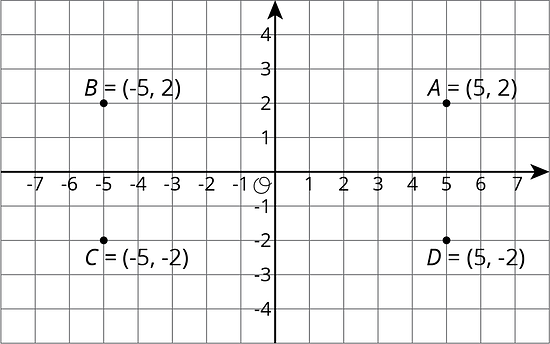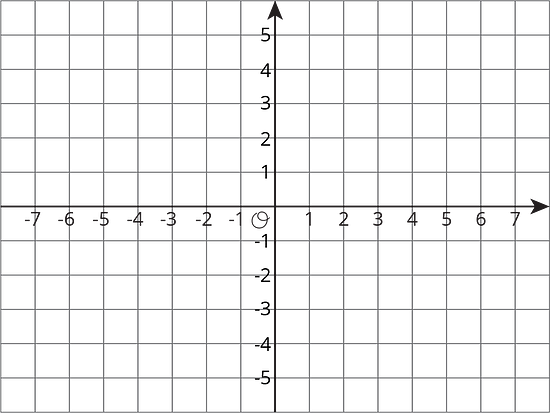Lesson 19Distances on a Coordinate Plane
Let’s explore distance on the coordinate plane.
Learning Targets:
- I can find horizontal and vertical distances between points on the coordinate plane.
19.1 Coordinate Patterns
Plot points in your assigned quadrant and label them with their coordinates.
19.2 Signs of Numbers in Coordinates
-
Next to each point, write its coordinates with the Text tool or Pen tool.
-
Answer these questions for each pair of points.
- How are the coordinates the same? How are they different?
- How far away are they from the y-axis? To the left or to the right of it?
- How far away are they from the x-axis? Above or below it?
-
and
-
and
-
and
Pause here for a class discussion.
-
Point has the same coordinates as point , except its -coordinate has the opposite sign.
- Plot point on the coordinate plane and label it with its coordinates.
- How far away are and from the -axis?
- What is the distance between and ?
-
Point has the same coordinates as point , except its -coordinate has the opposite sign.
- Plot point on the coordinate plane and label it with its coordinates.
- How far away are and from the -axis?
- What is the distance between and ?
-
Point has the same coordinates as point , except both of its coordinates have the opposite signs. In which quadrant is point ?
19.3 Finding Distances on a Coordinate Plane
-
Label each point with its coordinates.
-
Find the distance between each of the following pairs of points.
-
Point and
-
Point and
-
Point and
-
- Which of the points are 5 units from ?
- Which of the points are 2 units from ?
- Plot a point that is both 2.5 units from and 9 units from . Label that point and write down its coordinates.
Are you ready for more?
Priya says, “There are exactly four points that are 3 units away from .” Lin says, “I think there are a whole bunch of points that are 3 units away from .”
Lesson 19 Summary
The points , and are shown in the plane. Notice that they all have almost the same coordinates, except the signs are different. They are all the same distance from each axis but are in different quadrants.

We can always tell which quadrant a point is located in by the signs of its coordinates.
| quadrant | ||
|---|---|---|
| positive | positive | I |
| negative | positive | II |
| negative | negative | III |
| positive | negative | IV |
In general:
- If two points have -coordinates that are opposites (like 5 and -5), they are the same distance away from the vertical axis, but one is to the left and the other to the right.
- If two points have -coordinates that are opposites (like 2 and -2), they are the same distance away from the horizontal axis, but one is above and the other below.
Lesson 19 Practice Problems
Here are 4 points on a coordinate plane.

- Label each point with its coordinates.
- Plot a point that is 3 units from point . Label it .
- Plot a point that is 2 units from point . Label it .
Each set of points are connected to form a line segment. What is the length of each?
- A = and B =
- C = and D =
- E = and F =
On the coordinate plane, plot four points that are each 3 units away from point . Write the coordinates of each point.

Noah’s recipe for sparkling orange juice uses 4 liters of orange juice and 5 liters of soda water.
- Noah prepares large batches of sparkling orange juice for school parties. He usually knows the total number of liters, , that he needs to prepare. Write an equation that shows how Noah can find , the number of liters of soda water, if he knows .
- Sometimes the school purchases a certain number, , of liters of orange juice and Noah needs to figure out how much sparkling orange juice he can make. Write an equation that Noah can use to find if he knows .
For a suitcase to be checked on a flight (instead of carried by hand), it can weigh at most 50 pounds. Andre’s suitcase weighs 23 kilograms. Can Andre check his suitcase? Explain or show your reasoning. (Note: 10 kilograms 22 pounds)